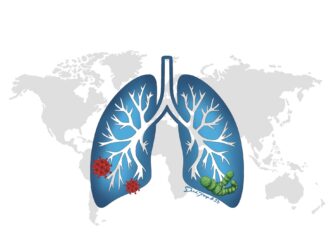The difference between COVID-19 and the Flu
Marianne Matzo, PhD, FAAN
We hear all sorts of opinions about opening our economy now…. after all, say some, COVID-19 is just a flu, and we don’t shut the world down for the flu. Do we really need to close business, stay at home and cancel our travel plans? Doesn’t this seem to be a hysterical, over-the-top response so something that even many tell us is not really that different from the common flu. But is COVID-19 “just the flu”?
So, I can save you a lot of time and tell you that COVID-19 is not like the seasonal flu. Now you can go back to doing what you were doing. But I can be more specific. After all, if something is worth doing, it’s worth overdoing.
COVID-19 is a different species from the flu. They are both viruses, but they are a different species. They are as different as human beings are from goats.
COVID-19 is an airborne virus. COVID-19 is spread through the airborne route, meaning that tiny droplets remaining in the air could cause disease in others even after the ill person is no longer near. One study (van Doremalen et al., 2020) documented that the time droplets can stay in the air for a full 2 hours. So, if you go to Lowe’s to buy a bird feeder and someone carrying COVID-19 coughed on them an hour ago, their COVID droplets could still be hanging there just waiting for you to walk by and take a breath. The flu is not an airborne virus. It is droplet spread. This means that you must actually be sneezed on to get you sick. This difference makes COVID-19 far more contagious than the flu.
COVID-19 is a more virulent disease than the flu. Virulence is the feature in a virus that determines how sick it will make you. With COVID-19, a little goes a long way, it is a very strong virus and will make you sick without hardly flexing a muscle. The flu, on the other hand requires a lot of virus particles to make you sick.
COVID-19 has a longer incubation period than the flu. It is the difference between incubating a human fetus in the uterus and waiting 9 months for a baby and the 15-day incubation time for a hamster to be born. When exposed to the flu virus it will usually take 1-2 days to get sick. This means you will be at home while you are contagious (because you are sick with the flu) (and why you should stay home with when you have the flu so that you do not make others sick). COVID-19 has an incubation time of 5-9 days after you are exposed to it. This gives you 5-9 days of having no symptoms but still being contagious enough to infect everyone you encounter.
COVID-19 will make you feel sick for a longer time than the flu does. After exposure to COVID-19 you are asymptomatically contagious (meaning you don’t feel sick, but you are spreading the virus all over town), then you have about a week of a cough and just not feeling well (some people never get actually sick, but are still contagious). This may progress to shortness of breath, possible hospital admission, intubation and on a ventilator and for some (2-4 weeks). All of this adds up to almost of month in which you can spread the virus. The flu has an average incubation of 1-2 days, you feel like hell for about 7 days, giving you a grand total of 9 infectious days with the seasonal flu.
COVID-19 is a lot more deadly than the flu. The flu has about a 0.2% mortality rate, which means that 2 out of every one-thousand people who get sick with flu will die. COVID-19 is 10 times more deadly than the flu (2% mortality rate). Age is a significant issue with COVID-19 mortality rates. If people under age 30 are not included (a smaller number of people under age 30 die from COVID-19) the death rate for adults is on average 4.5% (that is 9 out of every 200 adults that get COVID-19 will die from it). Mortality from COVID-19 increases with age, so the risk of dying gets increases as you get older.
So, what are the exact numbers? There are approximately 2,494,915 COVID-19 cases worldwide; 787,960 cases in the U.S. as of April 21, 2020. The flu saw an estimated 1 billion cases worldwide; 9.3 million to 45 million cases in the U.S. per year (Maragakis, 2020). So, yes, there were more cases of the flu. Remember flu symptoms are milder and they do not overwhelm the health care system in terms of need for hospitalizations and ventilators.
Regarding the number of deaths, approximately 171,249 COVID-19 deaths have been reported worldwide with 42,364 deaths in the U.S., as of Apr. 21, 2020 (6 months of time). Compare this to the YEARLY (12 months) flu death rate of 291,000 to 646,000 deaths worldwide and 12,000 to 61,000 deaths in the U.S. per year. The United States already has over 42,000 deaths as of 4/21/2020 compared to the maximum deaths reported of 61,000 in an entire year (Maragakis, 2020).
The thing with death, as we well know, is that dead is dead, there are no do-overs. So, with a virus like COVID-19, where there is no vaccine to help prevent it or reduce its severity, we need to treat it seriously to prevent a large death toll and overwhelming the hospital systems. The COVID-19 situation rapidly changes. Knowing the similarities and differences between these two viruses can help you stay informed so you can protect yourself and others from spreading either virus. Remember to wash your hands, social distancing, and home isolation to prevent the spread of both influenza and COVID-19. Realize that relaxing social distancing at this time will likely result in a second, and even likely a third wave of the virus and more deaths with each wave.
References
Maragakis, L. L. (2020). Coronavirus Disease 2019 vs. the Flu. Retrieved from https://www.hopkinsmedicine.org/health/conditions-and-diseases/coronavirus/coronavirus-disease-2019-vs-the-flu
van Doremalen, N., Bushmaker, T., Morris, D. H., Holbrook, M. G., Gamble, A., Williamson, B. N., . . . Munster, V. J. (2020). Aerosol and Surface Stability of SARS-CoV-2 as Compared with SARS-CoV-1. New England Journal of Medicine, 382(16), 1564-1567. doi:10.1056/NEJMc2004973








